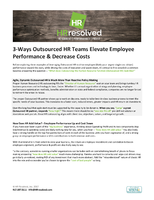ASHRAE addresses HVAC/R systems and disease transmission.
Press Release Summary:
As health officials deal with second wave of H1N1 virus, new information is available on consequences of exposure to such airborne infectious diseases and implications on design, installation, and operation of HVAC/R systems. ASHRAE's Airborne Infectious Diseases Position Document addresses impact of ventilation on disease transmission, the disease for which ventilation is important for either transmission or control, and control strategies for implementation in buildings.
Original Press Release:
Role of HVAC&R Systems in Infectious Disease Transmission Addressed by ASHRAE
ATLANTA -As health and school officials deal with a second wave of the H1N1 virus, commonly referred to as swine flu, new information is available on health consequences of exposure to such airborne infectious diseases and the implications on the design, installation and operation of HVAC&R systems.
"While the long-standing public health view is that influenza transmission occurs through direct contact or large droplets, newer data suggests it also occurs through the airborne route, meaning HVAC&R systems may contribute far more to transmission of the disease and, potentially, to reduction of that same transmission risk," said Gordon Holness, president of the American Society of Heating, Refrigerating and Air-Conditioning Engineering (ASHRAE) that developed the guidance.
ASHRAE's Airborne Infectious Diseases Position Document addresses the impact of ventilation on disease transmission, the disease for which ventilation is important for either transmission or control and the control strategies that are available for implementation in buildings. The paper can be read at http://www.ashrae.org/positiondocuments.
Since the first reported case in the spring of 2009, the H1N1 virus has spread to nearly 170 countries, resulting in 1,154 deaths and some 160,000 illnesses. With a better understanding of ventilation's effect on the transmission of disease, future incidents of the H1N1 virus may now be easier to prevent, according to Holness. He said several technical solutions are available to assist in avoiding transmission. These include: dilution ventilation, airflow strategies, room pressurization, personalized ventilation, source control, filtration and ultraviolet germicidal irradiation.
Airborne transmission through building ventilation systems can be significantly reduced by provision of adequate air filtration and pressurization, Holness said. ASHRAE's other guidance of relevance includes Standard 170, Ventilation of Health Care Facilities, and Standard 611, Air Quality Within Commercial Aircraft.
ASHRAE, founded in 1894, is an international organization of some 50,000 persons. ASHRAE fulfills its mission of advancing heating, ventilation, air conditioning and refrigeration to serve humanity and promote a sustainable world through research, standards writing, publishing and continuing education.
Contact: Jodi Dunlop
Public Relations
678-539-1140
jdunlop@ashrae.org




